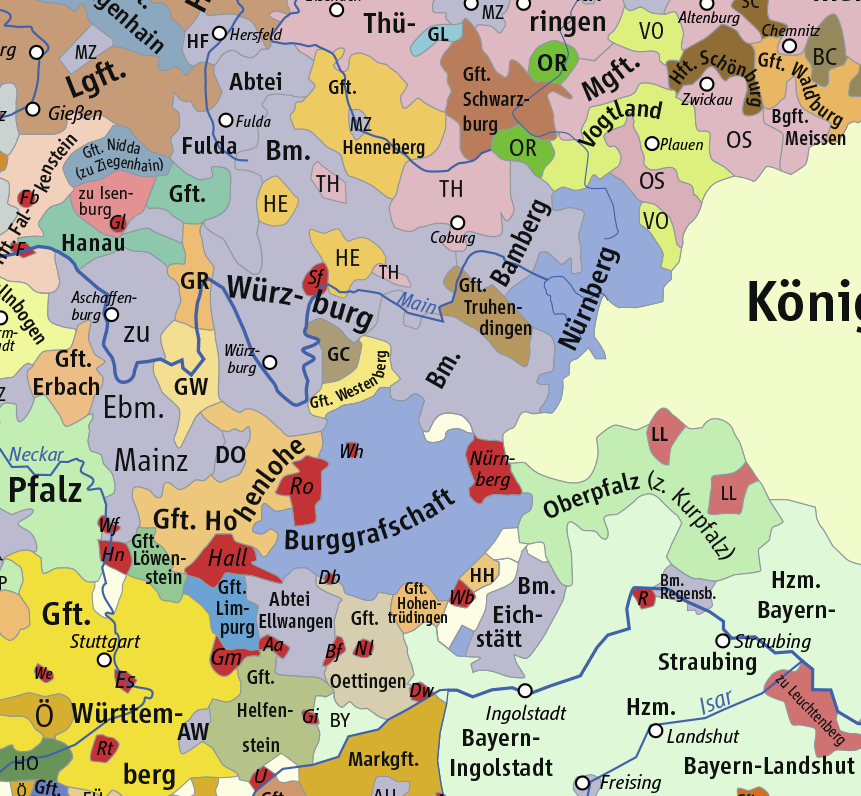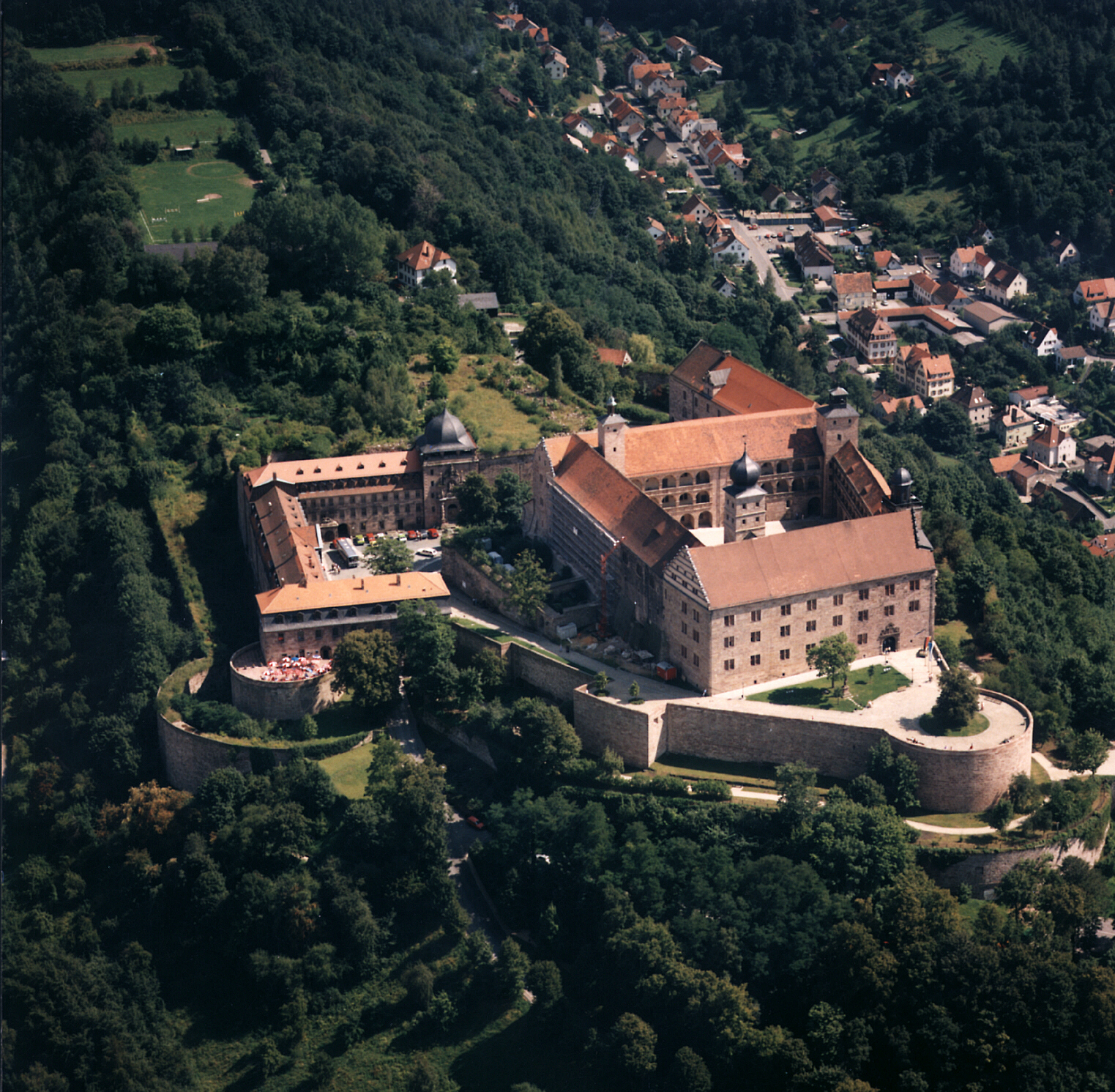|
Brandenburg-Kulmbach
The Principality of Bayreuth (german: Fürstentum Bayreuth) or Margraviate of Brandenburg-Bayreuth (''Markgraftum Brandenburg-Bayreuth'') was an immediate territory of the Holy Roman Empire, ruled by a Franconian branch of the Hohenzollern dynasty. Since Burgrave Frederick VI of Nuremberg was enfeoffed with the Margraviate of Brandenburg in 1415/17, the Hohenzollern princes transferred the margravial title to their Franconian possessions, though the principality never had been a march. Until 1604 they used Plassenburg Castle in Kulmbach as their residence, hence their territory was officially called the Principality of Kulmbach or Margraviate of Brandenburg-Kulmbach until the Empire's dissolution in 1806. Geography The Kulmbach-Bayreuth principality arose from the northern uplands (''Oberland'') of the former Burgraviate of Nuremberg, while the southern lowlands (''Unterland'') formed the Principality of Ansbach. The final border demarcation was settled by the 1541 House Trea ... [...More Info...] [...Related Items...] OR: [Wikipedia] [Google] [Baidu] |
House Of Hohenzollern
The House of Hohenzollern (, also , german: Haus Hohenzollern, , ro, Casa de Hohenzollern) is a German royal (and from 1871 to 1918, imperial) dynasty whose members were variously princes, electors, kings and emperors of Hohenzollern, Brandenburg, Prussia, the German Empire, and Romania. The family came from the area around the town of Hechingen in Swabia during the late 11th century and took their name from Hohenzollern Castle. The first ancestors of the Hohenzollerns were mentioned in 1061. The Hohenzollern family split into two branches, the Catholic Swabian branch and the Protestant Franconian branch,''Genealogisches Handbuch des Adels, Fürstliche Häuser'' XIX. "Haus Hohenzollern". C.A. Starke Verlag, 2011, pp. 30–33. . which ruled the Burgraviate of Nuremberg and later became the Brandenburg-Prussian branch. The Swabian branch ruled the principalities of Hohenzollern-Hechingen and Hohenzollern-Sigmaringen until 1849, and also ruled Romania from 1866 to 1947. Members o ... [...More Info...] [...Related Items...] OR: [Wikipedia] [Google] [Baidu] |
John, Margrave Of Brandenburg-Kulmbach
John, nicknamed the Alchemist (german: Johann der Alchimist; 1406 – 16 November 1464) was a Margrave of Brandenburg-Kulmbach and served as the peace-loving Margrave of Brandenburg after the abdication of his father, Frederick I, the first member of the House of Hohenzollern to rule Brandenburg. Biography John was the eldest son of Frederick I, Margrave of Brandenburg (1371–1440), and Elisabeth of Bavaria-Landshut (1383–1442), daughter of Frederick, Duke of Bavaria, and his second wife Maddalena Visconti. After marrying Barbara of Saxe-Wittenberg (1405–1465), daughter of Rudolf III, Duke of Saxe-Wittenberg, John hoped to eventually succeed to Saxe-Wittenberg once its line of Ascanian dukes died out. When this happened in November 1422, however, Emperor Sigismund was on poorer terms with the Hohenzollerns and was only willing to compensate John with a monetary payment. John began participating in governmental affairs in Brandenburg in 1424. Frustrated by disputes with th ... [...More Info...] [...Related Items...] OR: [Wikipedia] [Google] [Baidu] |
Hof, Bavaria
Hof () is a town on the banks of the Saale in the northeastern corner of the German state of Bavaria, in the Franconian region, at the Czech border and the forested Fichtelgebirge and Frankenwald upland regions. The town has 47,296 inhabitants, the surrounding district an additional 95,000. The town of Hof is enclosed by, but does not belong to the Bavarian district of Hof; it is nonetheless the district's administrative seat. The town's most important work of art, the Hofer altar, dates from about 1465 and is exhibited in the Alte Pinakothek in Munich today. The Heidenreich organ in the parish church of St. Michaelis, completed in 1834, is considered one of Bavaria's finest. Hof is known for two local "delicacies", namely , a kind of hotpot, and sausages boiled in a portable, coal-fired brass cauldron, which are sold in the streets by the ''sausage man'' ( in the local dialect). There is also a particularly strong beer (), which is available only on the first Monday after ... [...More Info...] [...Related Items...] OR: [Wikipedia] [Google] [Baidu] |
Frederick I, Elector Of Brandenburg
Frederick (Middle High German: ''Friderich'''','' Standard German: ''Friedrich''; 21 September 1371 – 20 September 1440) was the last Burgrave of Nuremberg from 1397 to 1427 (as Frederick VI), Margrave of Brandenburg-Ansbach from 1398, Margrave of Brandenburg-Kulmbach from 1420, and Elector of Brandenburg (as Frederick I) from 1415 until his death. He became the first member of the House of Hohenzollern to rule the Margraviate of Brandenburg. Biography Frederick was born in Nuremberg, the second-born son of Burgrave Frederick V (1333–1398) and the Wettin princess Elisabeth of Meissen. He entered early into the service of his brother-in-law, the Habsburg duke Albert III of Austria. After Albert's death in 1395, he fought on the side of the Luxembourg king Sigismund of Hungary against invading Ottoman forces. He and his elder brother John, husband of Sigismund's sister Margaret of Bohemia, fought in the 1396 Battle of Nicopolis where they suffered a disastrous ... [...More Info...] [...Related Items...] OR: [Wikipedia] [Google] [Baidu] |
Plassenburg
Plassenburg is a castle in the city of Kulmbach in Bavaria. It is one of the most impressive castles in Germany and a symbol of the city. It was first mentioned in 1135. The Plassenberg family were ministerial of the counts of Andechs (later the dukes of Andechs-Meranien) and used as their seat the Plassenburg. The House of Guttenberg, a prominent Franconian noble family, traces its origins back to 1149 with a Gundeloh v. Blassenberg (Plassenberg). The name Guttenberg is derived from Guttenberg and was adopted by a Heinrich von Blassenberg around 1310. From 1340, the Hohenzollerns governed from Plassenburg castle their territories in Franconia till 1604. The Plassenburg was fortress and residence for the Hohenzollerns. It was destroyed in 1554 at the end of the second Margravian war (1552–1554) of margrave Albert Alcibiades. The Plassenburg was later rebuilt by the architect Caspar Vischer as an impressive stronghold and as a huge palace. In 1792, Margrave Alexander so ... [...More Info...] [...Related Items...] OR: [Wikipedia] [Google] [Baidu] |
Kulmbach
Kulmbach () is the capital of the district of Kulmbach in Bavaria in Germany. The town is famous for Plassenburg Castle, which houses the largest tin soldier museum in the world, and for its sausages, or '' Bratwürste''. Geography Location Kulmbach is located in the middle of the Bavarian province of Upper Franconia, about northwest of the city of Bayreuth. To the south of Kulmbach, the River Main begins at the confluence of its headstreams, the White Main and Red Main. Town districts Kulmbach is divided into the following districts (with population in brackets): History From about 900 AD there was a small settlement in what is now the district of Spiegel, which consisted of a forest lodge and a fortified tenant farm (''Fronhof'') to protect the river Main crossing at Grünwehr. The area later passed into the hands of the Count of Schweinfurt, whose power was usually exercised through the office of the . Kulmbach was first mentioned as ''Kulma'' in a deed o ... [...More Info...] [...Related Items...] OR: [Wikipedia] [Google] [Baidu] |
Bayreuth
Bayreuth (, ; bar, Bareid) is a town in northern Bavaria, Germany, on the Red Main river in a valley between the Franconian Jura and the Fichtelgebirge Mountains. The town's roots date back to 1194. In the 21st century, it is the capital of Upper Franconia and has a population of 72,148 (2015). It hosts the annual Bayreuth Festival, at which performances of operas by the 19th-century German composer Richard Wagner are presented. History Middle Ages and Early Modern Period The town is believed to have been founded by the counts of Andechs probably around the mid-12th century,Mayer, Bernd and Rückel, Gert (2009). ''Bayreuth – Tours on Foot'', Heinrichs-Verlag, Bamberg, p.5, . but was first mentioned in 1194 as ''Baierrute'' in a document by Bishop Otto II of Bamberg. The syllable ''-rute'' may mean ''Rodung'' or "clearing", whilst ''Baier-'' indicates immigrants from the Bavarian region. Already documented earlier, were villages later merged into Bayreuth: Seulbitz (i ... [...More Info...] [...Related Items...] OR: [Wikipedia] [Google] [Baidu] |
Brandenburg-Ansbach
The Principality or Margraviate of (Brandenburg-)Ansbach (german: Fürstentum Ansbach or ) was a principality in the Holy Roman Empire centered on the Franconian city of Ansbach. The ruling Hohenzollern princes of the land were known as margraves, as their ancestors were margraves (so the principality was a margraviate but not a march). History The principality was established at the death of Frederick V, Burgrave of Nuremberg, on 21 January 1398, when his lands were partitioned between his two sons. The younger son, Frederick VI, received Ansbach and the elder, John III, received Bayreuth. After John III's death on 11 June 1420, the two principalities were reunited under Frederick VI, who had become Elector Frederick I of Brandenburg in 1415. Upon Frederick I's death on 21 September 1440, his territories were divided between his sons; John received the principality of Bayreuth (Brandenburg-Kulmbach), Frederick received Brandenburg, and Albert received Ansbach. Thereafter ... [...More Info...] [...Related Items...] OR: [Wikipedia] [Google] [Baidu] |
Free Imperial City Of Nuremberg
The Imperial City of Nuremberg (german: Reichsstadt Nürnberg) was a free imperial city — independent city-state — within the Holy Roman Empire. After Nuremberg gained piecemeal independence from the Burgraviate of Nuremberg in the High Middle Ages and considerable territory from Bavaria in the Landshut War of Succession, it grew to become one of the largest and most important Imperial cities, the 'unofficial capital' of the Empire, particularly because numerous Imperial Diets () and courts met at Nuremberg Castle between 1211 and 1543. Because of the many Diets of Nuremberg, Nuremberg became an important routine place of the administration of the Empire during this time. The Golden Bull of 1356, issued by Emperor Charles IV (reigned 1346–78), named Nuremberg as the city where newly elected kings of Germany must hold their first Imperial Diet, making Nuremberg one of the three highest cities of the Empire. The cultural flowering of Nuremberg, in the 15th and 16th centu ... [...More Info...] [...Related Items...] OR: [Wikipedia] [Google] [Baidu] |
House Treaty Of Regensburg
The House Treaty of Regensburg was a treaty concluded on 23 July 1541 between two branches of the House of Hohenzollern, defining the boundaries between the newly created principalities of Ansbach and Kulmbach. These two territories had been created when in 1486 the Burgraviate of Nuremberg (the Hohenzollern's Franconian possessions) had been divided according to the Dispositio Achillea. The Burgraviate of Nuremberg consisted of a ''lower part'' around Ansbach and an ''upper part'' around Bayreuth and Kulmbach, separated by the ''Muggendorfer Mountains'' – the term used back then for the mountain range now called '' Little Switzerland''. At the 1486 division, the lower part of the Burgraviate was awarded to Frederick I and the upper part to his brother Siegmund. This division took the geographical conditions into account, but not the economic possibilities of the two new principalities. The soil in the lower part of the Burgraviate was more fertile and this led to Frederick r ... [...More Info...] [...Related Items...] OR: [Wikipedia] [Google] [Baidu] |
Principality Of Ansbach
The Principality or Margraviate of (Brandenburg-)Ansbach (german: Fürstentum Ansbach or ) was a principality in the Holy Roman Empire centered on the Franconian city of Ansbach. The ruling Hohenzollern princes of the land were known as margraves, as their ancestors were margraves (so the principality was a margraviate but not a march). History The principality was established at the death of Frederick V, Burgrave of Nuremberg, on 21 January 1398, when his lands were partitioned between his two sons. The younger son, Frederick VI, received Ansbach and the elder, John III, received Bayreuth. After John III's death on 11 June 1420, the two principalities were reunited under Frederick VI, who had become Elector Frederick I of Brandenburg in 1415. Upon Frederick I's death on 21 September 1440, his territories were divided between his sons; John received the principality of Bayreuth (Brandenburg-Kulmbach), Frederick received Brandenburg, and Albert received Ansbach. There ... [...More Info...] [...Related Items...] OR: [Wikipedia] [Google] [Baidu] |
Burgraviate Of Nuremberg
The Burgraviate of Nuremberg (german: Burggrafschaft Nürnberg) was a state of the Holy Roman Empire from the early 12th to the late 15th centuries. As a burgraviate, it was a county seated in the town of Nuremberg; almost two centuries passed before the burgraviate lost power over the city, which became independent from 1219. Eventually, the burgraviate was partitioned to form Brandenburg-Ansbach and Brandenburg-Bayreuth. History Nuremberg was probably founded around the turn of the 11th century, according to the first documentary mention of the city in 1050, as the location of an Imperial castle between the East Franks and the Bavarian March of the Nordgau.Nürnberg, Reichsstadt: Politische und soziale Entwicklung (Political and Social Devel ... [...More Info...] [...Related Items...] OR: [Wikipedia] [Google] [Baidu] |




